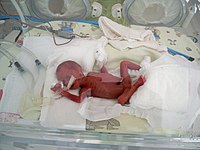
Photo from wikipedia
BACKGROUND The association between multiple metal concentrations and gestational diabetes mellitus (GDM) is poorly understood. METHODS A total of 776 women with GDM and an equal number of controls were… Click to show full abstract
BACKGROUND The association between multiple metal concentrations and gestational diabetes mellitus (GDM) is poorly understood. METHODS A total of 776 women with GDM and an equal number of controls were included in the study. Concentrations of metals in participants' blood (nickel (Ni), arsenic (As), cadmium (Cd), antimony (Sb), thallium (Tl), mercury (Hg), lead (Pb)) were measured using inductively coupled plasma-mass. We used unconditional logistical regression models to estimate the associations between metals and GDM. We also employed weighted quantile sum (WQS) regression and principal components analysis (PCA) to examine metal mixtures in relation to GDM. RESULTS An increased risk of GDM was associated with As (OR = 1.49, 95% CI: 1.11, 2.01 for the 2nd tertile vs. the 1st tertile) and Hg (OR = 1.43, 95% CI: 1.09, 1.88 for the 3rd tertile vs. the 1st tertile). In WQS analysis, the WQS index was significantly associated with GDM (OR = 1.20, 95% CI: 1.02, 1.41). The major contributor to the metal mixture index was Hg (69.2%), followed by Pb (12.8%), and As (11.3%). Based on PCA, the second principal component, which was characterized by Hg, Ni, and Pb, was associated with an increased risk of GDM (OR = 1.46, 95% CI: 1.02, 2.08 for the highest quartile vs. the lowest quartile). CONCLUSIONS Our study results suggest that high metal levels are associated with an increased risk of GDM, and this increased risk is mainly driven by Hg and, to a lesser extent, by Ni, Pb, and As.
Journal Title: Chemosphere
Year Published: 2019
Link to full text (if available)
Share on Social Media: Sign Up to like & get
recommendations!